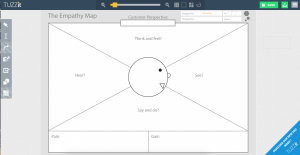Directions:
Now that you have thought through who is impacted by your wicked problem, take it a step further and hypothesize what those individuals might think and feel, hear, see, say, and do along with how the problem causes them pain and what they might gain if the problem was remedied for them.
To complete this activity, please document these considerations using TUZZit’s Empathy Map tool. Once you click the link, you will next need to click “next” button and then scroll to the right a few times until you see the Empathy Map template. Click the “Use” option to access the template.
When finished, add a link to your empathy maps in the comments box below! To access the link, you will need to click the green “Download Board Option” on the top right of the screen. Next, enter you email, and TUZZit will email you a link to your board. Paste that link into the comment box below.
NOTE: If you have a problem posting your empathy map, please double check that you are using your UNC email when trying to add a post. Also, refresh your screen to see if it appears. If after checking both of those items, you can email the link to your empathy or a screenshot of it to tcherner@unc.edu.
Access:
Direct link to TUZZit’s empathy map.
https://board.tuzzit.com/board_space/96262009-bd72-42fa-82c9-9f9aa03d9403/capture.png?1586032906


69 Responses to “2.4 – Create an Empathy Map!”
Jesse Hunt
My Empathy Map
Jesse Hunt
Empathy Map!
tcherner
For Xinjuan
https://board.tuzzit.com/ownerboard/8c33bc19-48d3-4abf-bf1e-b362c7f700f5#/
tcherner
For Monique
https://board.tuzzit.com/ownerboard/b3499407-44f2-4586-8ccc-64125678e067#/
Julia Thompson
https://board.tuzzit.com/ownerboard/a2cb0eb5-9da0-4290-a8ab-1fb577e6be1c#/
Dannielle
https://board.tuzzit.com/ownerboard/bd661d5c-3c49-4521-8710-cf58e6579a40#/
Julia
https://board.tuzzit.com/ownerboard/a2cb0eb5-9da0-4290-a8ab-1fb577e6be1c#/
Izzete Encarnacion
Hello! I hope you can give me useful feedback !
https://board.tuzzit.com/just/73804b64-8c1b-4d9b-a911-26b88f652d6e#/
Izzete Encarnacion
Hello!
https://board.tuzzit.com/just/73804b64-8c1b-4d9b-a911-26b88f652d6e#/
Izzete Encarnacion
https://board.tuzzit.com/just/73804b64-8c1b-4d9b-a911-26b88f652d6e#/
Nate Orecchio
https://board.tuzzit.com/ownerboard/3233979f-3924-4818-a44b-69f4f9b72d2f#/
Hilli Goldhar
https://board.tuzzit.com/ownerboard/6b4a7d43-a000-4928-b24b-67c0accaf102#/
tcherner
For Aidana
https://board.tuzzit.com/ownerboard/31c480cd-bf5d-4d0d-b4aa-6c8ab40e44cf#/
Andrea Melendez
https://board.tuzzit.com/embed/85025802-713f-4e81-a177-07427cb9d4f6
Megan Byers
https://board.tuzzit.com/ownerboard/5fcd7525-d392-4534-ae15-2a3d96316653#/
Austin O'Connor
I think this is the proper way to post it, but it won’t send the actual board to my email.
Daniels Akpan
A glimpse on who is being impacted by my wicked problem and how they feel, think, see things and what they do.
David Russo
https://board.tuzzit.com/just/ddf85784-4d58-4460-9fc0-4551198918cc#/
Grace Willard
DEI Empathy Map for client
Grace Willard
https://board.tuzzit.com/ownerboard/40704353-eb5f-46c8-b6dc-ae6e52266791#/
tcherner
For Karen Vaughn
https://board.tuzzit.com/ownerboard/0ba21020-d10c-4c4c-99dd-3c2043cba50c#/
Jackie Russo
Empathy map- https://board.tuzzit.com/just/9ab4fe57-5eb4-4ddb-98c3-954ed6bea28a#/
J Russo
Empathy map- https://board.tuzzit.com/just/9ab4fe57-5eb4-4ddb-98c3-954ed6bea28a#/
Emma Goldin
Empathy Map: https://board.tuzzit.com/ownerboard/44ea167f-1c21-416e-9084-c239214679a8#/
Mariana Pineda
Empathy Map
Steven Llewellyn
Here is my TUZZit
Jasmine Johnson
https://board.tuzzit.com/ownerboard/4bb43e84-4bfd-47b2-854f-6a7a186c10d8#/
Jasmine Johnson
Link: https://board.tuzzit.com/ownerboard/4bb43e84-4bfd-47b2-854f-6a7a186c10d8#/
Alexander Conte
Here is my map: https://board.tuzzit.com/just/d1942f84-6848-4f3d-b93f-c910ba95d69d#/
Savita madan
https://board.tuzzit.com/ownerboard/907e035c-df10-4722-ab31-229ee3d9849b
Jessica Schultz
https://board.tuzzit.com/ownerboard/0dea88a1-ad90-4ab1-8302-e45b42178e0d#/
Jeremy Dickerson
Empathy Map =
https://board.tuzzit.com/ownerboard/8d3255e7-f6de-4ae8-a4e3-5a0421a669fc#/
Jeremy Dickerson
Jeremy’s Empathy Map
Alisha Neblett Thompson
Here is my map: https://board.tuzzit.com/ownerboard/9a811c03-bcb0-4d64-bc93-2c0830260f03#/
Jeremy Dickerson
Jeremy’s Empathy Map
Jaelynn Murray
Empathy Map
Mariana Pineda
https://board.tuzzit.com/ownerboard/fe4380bf-4f03-4197-aa0c-aa4c59b5130b#/
Jeremy Dickerson
Empathy Map
Emily
https://board.tuzzit.com/ownerboard/1bb60e4d-e8d0-4614-b809-e1e76e429ce7#/
Taylor Redmond
https://board.tuzzit.com/ownerboard/477735d4-0c8b-4c29-b3f5-54c1c9e6b7f7#/
Yeeva Cheng
Here’s my Empathy Map: https://board.tuzzit.com/embed/d552f70c-8885-43ee-a493-f423034af7cf
Taylor Moreno
https://board.tuzzit.com/ownerboard/1f7e47bb-7971-4e81-ad52-11e25a38b87e#/
Ron Bush
https://board.tuzzit.com/ownerboard/66313a2c-5a23-4b8b-99f8-0a0237bb2af2#/
Shiqi Tao
https://board.tuzzit.com/just/42672351-860f-45ef-9b11-1deeff34911b#/
Jianing L
https://board.tuzzit.com/ownerboard/8203be87-a546-42a6-9ce3-4f6d681ff462#/
Erica Harreveld
https://board.tuzzit.com/ownerboard/69e33813-aa47-4da2-8061-1e3d2af66c75#/
Jane McDaniel
Empathy map for medical students: https://board.tuzzit.com/ownerboard/1e2a3a0f-ed84-4060-82c6-3a9ad24bc80f#/
April McKinley
https://board.tuzzit.com/board/bad5f821-5b47-40cf-9eda-ba13c6429b72#/
Rebecca Elliott
https://board.tuzzit.com/ownerboard/8b2ad574-6531-4380-9c1e-b33a77d3bac8#/
Bennett T. Dansby
Empathy Board: Screen time
https://board.tuzzit.com/board_space/783e073e-ec03-4d38-94d0-96a9a69c1a4d/capture.png?1598980876
Alexandra
My link did not post!
https://board.tuzzit.com/just/8cf4f462-c956-4ea3-b5d4-4a447bbebe3c#/
Ahmed
This is my map, https://board.tuzzit.com/ownerboard/8a729cb1-8a01-4b66-b5b7-0fd6ac04fa68#/
Katie Bourque
My wicked problem empathy map: https://board.tuzzit.com/ownerboard/344ae783-01ed-499c-9531-6c6dc74188a5#/
Claire Paulson
My wicked problem empathy map: https://board.tuzzit.com/board/6fa73567-b243-4782-ac2d-d02363ed2965#/
Melissa Lobosco
Here is my link: https://board.tuzzit.com/ownerboard/1eae78be-132c-4b42-a3c6-b8f36d237510#/
Elyse Smith
Board About Students:
https://board.tuzzit.com/board/d222964a-6d03-4698-b524-a3fb9719b2e6#/
Board About Faculty:
https://board.tuzzit.com/ownerboard/ebfcfcc9-ed90-4bb5-ae26-38c17722b823#/
Savannah Windham
Here is a link to my empathy map: https://board.tuzzit.com/just/5d2a4c54-9dab-43c2-a7a2-da1aee36d6d2#/
Erika Murray
This is my board, https://board.tuzzit.com/ownerboard/f4ebb757-c176-48cf-8711-d1f7c0b8793d#/
Marvin
Empathy Map
Michael Berro
https://board.tuzzit.com/just/995d55fe-f275-4ce1-9265-5911e011e6cf#/
Dorrian Wilson
https://board.tuzzit.com/just/95c8731b-b226-407c-ae21-73f268ced249#/
Alexandra
Empathy Map
Amanda Luz
https://board.tuzzit.com/board_space/e3ea31c3-a811-4506-8e6c-ea69516519da/capture.png?1598395081
Devon Young
Empathy map: https://board.tuzzit.com/ownerboard/4c11d070-ec75-4c53-9cac-d6831d490f1a#/
Ebenezer Lancerio
Link to empathy map: https://board.tuzzit.com/ownerboard/c6aadeef-48fd-440e-b659-1768366428e6#/
Bronwyn manley
I might have 2 problems in one here and have to dissect it. It’s challenging when you are identifying problems you ‘think’ exist but the problem might be unrelated (hence needing target audience to collaborate with on this)!
Diane Boswell
Empathy Map
D
Empathy Map https://board.tuzzit.com/board_space/c1c2fdd8-0805-47f4-b319-11e5f9390edb/capture.png?1598219227
Diane Boswell
Use this version!!! https://board.tuzzit.com/board/c1c2fdd8-0805-47f4-b319-11e5f9390edb#/